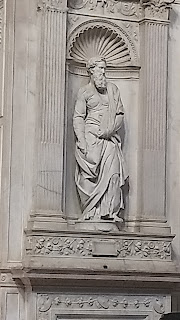Among all the fascades of cathedrals we saw, Orvieto's was the most elaborate. Watching Rick Steve's PBS program months before, I remember being blown away. Standing face to face with the church was extraordinary. Inside, we marveled again at ornate art in suti and viewed the two side chapels.

In one, the corporal chapel, rests the relic which caused the cathedral was built. In 1263, a priest who doubted that the Eucharist could actually become the body and blood of Christ was surprised (pleasantly or otherwise being lost to legend) to find the elements seeping blood. The stained cloth is preserved behind the chapel's reliquary to this day.
In the other chapel, a brightly colored mural depicting the last judgement met our wandering eyes. The crowning achievement in the career of Signorelli, these paintings predate the Reformation, but in Florence a Dominican priest named Savoronella had gained prominence and was challenging the authority of the church in Rome. Sick of all the nude people the artists had been detailing, he was burning art and books, and seeing his impact in Florence had the rest of the Catholic world thinking of the end times when the Antichrist would deceive the unfaithful.
After viewing the Duomo, we stopped by a sandwich shop for some pork sandwiches. Always desiring idyllic scenery for her picnic, Alex led a hungry Arthur outside the city walls to walk around the base of the cliff but the trail lead into a briar patch. We backtracked and settled on a park at what was once an ancient fortress. We both remember the park fondly, though finally getting to eat makes every memory more enjoyable for Arthur.
With only a while to go before the train would take us to Rome, we got some gelato and hung outside the Duomo for a while people watching-- tourists getting on and off buses, kids running home after school, and locals going about their daily business. Orvieto had been a wonderful stop, but now we were headed to our prime destination. Alex was nervous about the crowds; Arthur could think of little other than all the architecture they would behold.
Our start in Rome began perhaps a tad inauspiciously. Alex, the ever trusty navigator, took a tad longer than usual to get us oriented properly, but we patiently made our way to the convent that would house us the next four nights. (It is easy to get disoriented popping up out from the underground metro in a foreign city you have never been in before.) We were welcomed in graciously to a spacious room and bathroom, perfect for our laundry.
Our first night, we ate at the convent and were treated very well. The meal came in five hearty courses with delectable pastas and meats. While the food wasn't as fancy as some of our meals it was probably a good representation of what a family would gather to eat. And there was a lot of food. Around us, eight other guests chatted together quietly. Among ten of us, we counted four different languages spoken.
After dinner, not quite ready for bed, we took a walk in the great city. Rome at night is beautiful; the temperature was just right, and our excitement kept us moving. We got our first sight of St. Peter's, walked across the Angel bridge, guarded by Bernini sculptures, and walked past the massive Justice Building. At long last, we headed back to the convent (curfew is at 11) and prepared for our first day in the Eternal City. Omnia Vincit Amour.

























